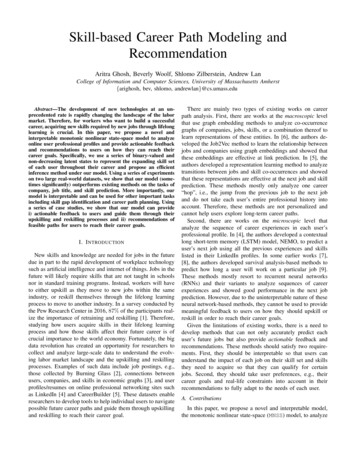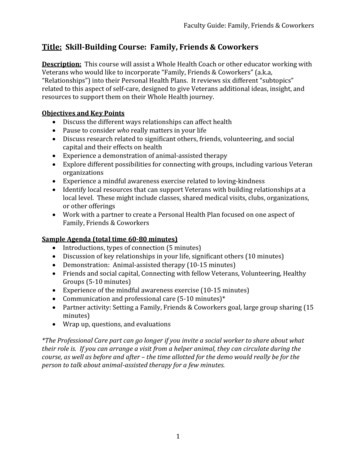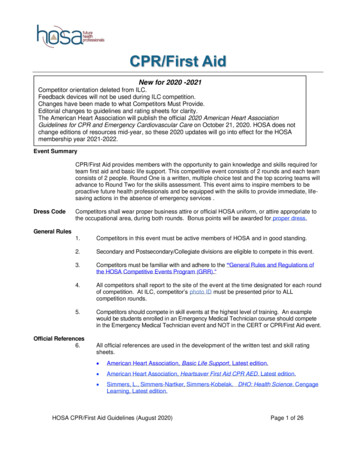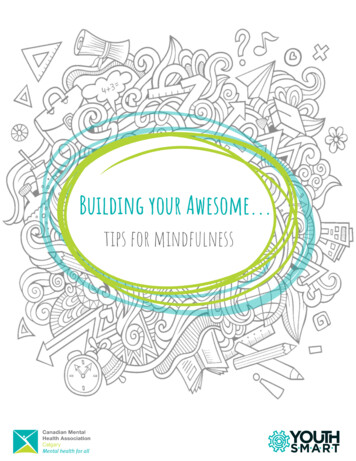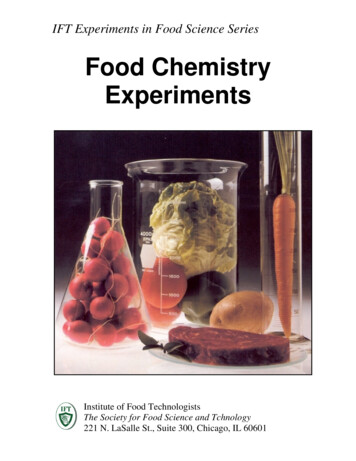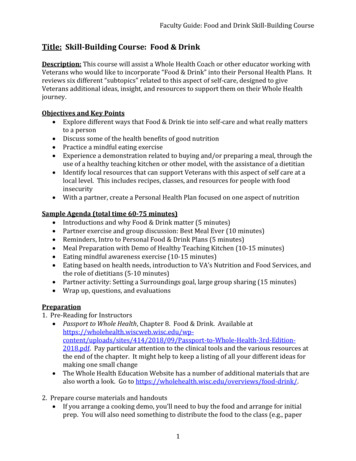
Transcription
Faculty Guide: Food and Drink Skill-Building CourseTitle: Skill-Building Course: Food & DrinkDescription: This course will assist a Whole Health Coach or other educator working withVeterans who would like to incorporate “Food & Drink” into their Personal Health Plans. Itreviews six different “subtopics” related to this aspect of self-care, designed to giveVeterans additional ideas, insight, and resources to support them on their Whole Healthjourney.Objectives and Key Points Explore different ways that Food & Drink tie into self-care and what really mattersto a person Discuss some of the health benefits of good nutrition Practice a mindful eating exercise Experience a demonstration related to buying and/or preparing a meal, through theuse of a healthy teaching kitchen or other model, with the assistance of a dietitian Identify local resources that can support Veterans with this aspect of self care at alocal level. This includes recipes, classes, and resources for people with foodinsecurity With a partner, create a Personal Health Plan focused on one aspect of nutritionSample Agenda (total time 60-75 minutes) Introductions and why Food & Drink matter (5 minutes) Partner exercise and group discussion: Best Meal Ever (10 minutes) Reminders, Intro to Personal Food & Drink Plans (5 minutes) Meal Preparation with Demo of Healthy Teaching Kitchen (10-15 minutes) Eating mindful awareness exercise (10-15 minutes) Eating based on health needs, introduction to VA’s Nutrition and Food Services, andthe role of dietitians (5-10 minutes) Partner activity: Setting a Surroundings goal, large group sharing (15 minutes) Wrap up, questions, and evaluationsPreparation1. Pre-Reading for Instructors Passport to Whole Health, Chapter 8. Food & Drink. Available 3rd-Edition2018.pdf. Pay particular attention to the clinical tools and the various resources atthe end of the chapter. It might help to keep a listing of all your different ideas formaking one small change The Whole Health Education Website has a number of additional materials that arealso worth a look. Go to .2. Prepare course materials and handouts If you arrange a cooking demo, you’ll need to buy the food and arrange for initialprep. You will also need something to distribute the food to the class (e.g., paper1
Faculty Guide: Food and Drink Skill-Building Course cups and plastic spoons). Talk to the teaching kitchen staff about a recipe that couldbe usedFor the mindful awareness eating experience, you will NOT need food items; this isan entirely visualization-based exerciseEach participant will receive a copy of the Veteran Handout designed to accompanythis courseYou may also wish to provide some of the Whole Health Library’s Veteran handoutsrelated to Food & Drink, available andouts/index.asp#foodand-drinkIt may be easiest to have handouts at participants’ seats, or you can pass themaround later. Review the handout in advance, so you can be ready for questionsBe sure to have evaluations form ready to give them at the end as well. There is ageneral, one-page form available as part of the course materials3. Set up AV and other equipment Be prepared to share the PowerPoint slides related to this course. A guide to each ofthe individual slides is featured later in this faculty guide Connect with the AV support person at your site A flip chart and markers, or a dry erase board, may be helpful as you conduct groupdiscussions If you do not have a slide projector, you can simply take them through the Veteranhandout after you give each person a copy. Alternatively, you can print out theslides and give them copies. Then, just take them through the slides, following thefaculty guide4. Identify local and other resources This is a great opportunity to invite one or more dietitians to join you with theteaching. They can help with the teaching kitchen/food preparation demo, as wellas be part of the discussion about how dietitians can help Add to the slide set (and/or Veteran Handout) to include local resources, includingo Local food banks or food pantrieso Nutrition and cooking classes available locallyo Any Veteran-run gardens or local farmers’ marketso Healthy local fast food options in the areao Guidance for eating healthy in the VA Cantina Develop your own list of favorite resources. Ask your dietitian colleagues for theirs,too2
Slide-By-Slide GuideFaculty Guide: Food and Drink Skill-Building Course Change this slide to incorporate your name, as well asthe date and location of the presentationThis is a good time to introduce yourself. Be sure toshare your own title/role related to the VAMight be worth it to have the participants do quickintroductions as well, but be mindful of timeFood & Drink is the most common topic that comes upof all the self-care areas (the green circles) whenpeople want to choose one area of focusThis is the list of learning objectives for the course.You can review these in detail, or go quickly overthem to save time. Bottom line: nutrition is a vasttopic, and there are a lot of different angles to look atit fromAs you move through, remember the subtitle for thiscircle is “Nourishing and Fueling.” Can ask them whatit means to be “nourished.” What fills up your tank orenergizes you?The intent is to get them thinking about how they eatand the resources where they can learn moreWould put the question on this slide out to the largegroup, but could do it as a partner exercise too. Timewill be tight for this module, so large group discussionis probably easierRead the quote as you feel appropriateWhen you served, you had tools – weapons, vehicles,and other technology, that had parts that had to becared for. Things only operated right if youmaintained them properly. For this car, every parthas to be functioning for the care to work.The same is true with your body. It is a tool thatallows you to accomplish your goals and live your life.When you eat food, that food powers the millions ofchemical reactions that determine how well yourbody will work.3
Faculty Guide: Food and Drink Skill-Building Course This slide is optional. Be sure to read the comic aloudsince it is hard to see.The goal here is to emphasize that our food becomesus. Different parts of our body are re-created over agiven period of time. For example, our gut lining willbe made of completely different molecules about aweek from now. All the water molecules in our bodychange in 16 days. In 6 months, we will have all-newmolecules in our hearts.In case you want to share, the top molecule on thisslide is glucose, the middle one is DNA, and thebottom one is heme, the molecule that allows our redblood cells to carry oxygenYou can ask them if they know that what you eat anddrink can affect their health. Everyone will likely say“yes.” Point out that most people know it; they justwant to know the practical aspects about how tochange their actionsCan ask them to share times in their lives when theythink eating made a difference to their health The same is true with being not only with how you doin the present, but with how eating will affect you inthe future This is a fun exercise for people to do – very popularin the Eating for Whole Health courseGive them at least 2-3 minutes each to share 4
Faculty Guide: Food and Drink Skill-Building Course Key points to make during the large group discussion:o Other parts of the circle come into play – it isn’tjust the taste of the foodo Relationships mattero Setting/surroundings mattero How the meal made you feel also mattersInvite a few people to share their best meals andreflections with the large groupRemind them that with Whole Health, we always startwith what really matters (MAP), so it is helpful to tiein Food & Drink to thatDietitians in the VA consistently ask that with ourteaching, we respect that we are not trying to goagainst Nutrition and Food Service Policy, or askpeople to go beyond their scope of practice withnutrition recommendationsIf participants have questions about any of this,dietitians can be helpfulIf people have health problems, they should talk withtheir care team about the role of nutrition. We’lldiscuss this more laterWhat are some topics people can think about as theycome up with Food & Drink goals for their healthplans?We’ll move through each of these six topics inclockwise order. The goal is to give you ideas abouthow to set a Food & Drink Goal, which we will do atthe end of this course. Jot down any ideas you have aswe go“Creating Your Own Food & Drink Plan” is very closelytied to the “Make One Small Change” circleThe goal is to get people thinking right away aboutwhat they can do for themselves. How can people feelempowered to make healthy changes?5
Faculty Guide: Food and Drink Skill-Building Course People tend to cringe at the word “diet.” Use“approach to eating” or “eating style”While many popular diets focus on calories, wherethose calories come from is important too. 100calories of vegetables has different chemicals anddifferent health effects from 100 calories from adessertThat said, it isn’t about saying you can never havecertain things. It is about only having less-healthyfoods occasionally, and healthy foods more oftenBe sure to mention that some people deal with foodinsecurity or live in food deserts (not desserts) andmay have to be more strategic to eat healthilyThis is just to give them some general ideas, or aframework, for right now. They’ll actually create aplan (and can choose one of these options or otherswe’ll cover) at the end of the course.The next slides talk about examples of each of thesethree approachesEncourage them to make other suggestionsBe careful with mentioning fiber – needs vary,especially if people have digestive problems. MostAmericans don’t get enough fiberThere is good research that a handful of nuts a daycan improve lifespan and prevent heart disease (ahandful, not a canful.)Again, it is not about feeling deprived, but peopleoften find they can easily get rid of one specific thing,and that can be a great starting place to creating anoverall healthy lifestyle. Can be a specific food, likepeanut butter, cookies, or ice creamWith the animal fat, many experts push for 2 or lessservings of red meat per weekBe sure to recognize, though, that all of us wereinfluenced by our childhood and our culture, and wehave to decide what is and is not realistic6
Faculty Guide: Food and Drink Skill-Building Course Share some ideas of your own as well! This slide and the next can be omitted, but eating therainbow is a very simple and popular tip you’ll hearmentionedCan ask them, if time allows, why this is important.One answer: The colors of many fruits and veggiesare actually powerful “phyto-chemicals” that can helpyour body in many ways. Examples include betacarotene (orange, like in carrots), lycopene (red, likein tomatoes) and anthocyanins (purple, inblueberries). When we have a meal that is mostlywhite or tan, we miss out on these powerful healthpromotersThis is usually good for a laugh. Skittles andjellybeans don’t work very well either Take time to cover each of these bullets, one at a timeRead the examples, to give them a feel of what Food &Drink health plan goals could look like7
Faculty Guide: Food and Drink Skill-Building Course Many people shy away from cooking for themselves,because they don’t feel like they know howOthers don’t have a sense of how best to shop to gethealthy foodThis course’s Veteran handout features someresources that might help You can share a list of local resources here (or, if theyare helping, invite the dietitian who will be doing thedemo to share as well) If possible, this is a great time to welcome in thehealthy teaching kitchen people from your site. Alllarge VA sites have teaching kitchensThey can either describe some guidelines forshopping for healthy food, or talk about eating well ona budget, or do a cooking demo (ideally they’ll do thedemo, because people enjoy this change of pace andget to sample the food too)Offer to help distribute the food to the audience There are many ways to approach mindful eating.The main key is to simply pay close attention andnotice what you experience as you are eatingIf time allows, you can ask them for their definition ofmindful awareness, or share yours. One definition:“Being aware, in the present moment,nonjudgmentally, with kindness.”8
Faculty Guide: Food and Drink Skill-Building Course Time in the service isn’t about healthy or mindfuleating. People eat on the go, as a necessity, not aluxury. You are usually doing it under stress. It isimportant to watch your patterns and see if there issomething you want to changeThere is a script that can be read for this exerciseincluded with the course materialsThese mindful awareness exercises are alwaysoptionalLet them know they can talk about it as a group whenTake a pause for at least 15 seconds for people to beable to reflectYou can vary how much time you spend (or don’tspend) on each of these questions, based on timefactors This is the most complicated of the six circles, and thekey here is to avoid feeling like the instructor has tohave the answers based on their specific health issues– the key is to make them aware that dietitians andothers can guide them with this, but they should try toget guidance Again, don’t get caught up in trying to defend one dietor another – it never goes well. Most of the researchindicates that people who succeed are the ones whocan stick with their chosen eating plan for a length oftimeJust acknowledge these diets are out there, and keepreminding them that it isn’t ‘one size fits all.’ That iswhy Whole Health focuses on personalizing care.What does an individual think would help most?Intermittent fasting has been showing up more in theliterature. For some approaches, you simply choose aspecified period of time during the day to eat and fastthe rest of the time 9
Faculty Guide: Food and Drink Skill-Building Course You can ask how many people have tried at least oneof these. You don’t have to know them all in depth,and don’t recommend any specific onesOnce again, don’t feel you have to get caught up inindividual diets. Tell them to work with their careteam for that (and if there is a dietitian helping teachthis course, they will be very helpful here)And remind them that it may be easier to make onesmall change, instead of totally revamping how theyeat all at onceAgain, keep hammering home that they should workwith their care teams and start small so that they canhave good initial success that they can keep buildingonResearch continues to show that people don’t do sowell sticking to “diets,” especially if they are verydifferent from how a person usually eats. Choose away of eating that feels sustainableThese are some examples of how eating patternsmight affect certain aspects of healthAgain, just share these – don’t feel like you have tostart solving individuals’ health issuesSpeaking of dietitians.they can be a person’s allyboth for answering questions and for setting sharedgoals10
Faculty Guide: Food and Drink Skill-Building Course This slide is pretty self-explanatoryIf working with a dietitian, you can have them helpout with this section too, if they are willing Can ask if anyone has ever worked with a dietitianbefore Now might be a good time to remind them that theSubtitle to “Food and Drink” is “Nourishing andFueling.”A discussion of other ways to be nourished orenergized could be relevant here Ask them if they have other thoughts, beyond thoseon this list or that we have talked about up to thispointYou can either read all of these, or just let them readthem on their own as you highlight a few of yourfavorites11
Faculty Guide: Food and Drink Skill-Building Course The temptation is always to spend more time onlecture and less on experiential activities or skillbuilding. Give this last exercise at least 15 minutes,including discussionSome people may be hesitant, but encourage them towork with a partner if at all possible. If not, they canstill set a goal on their own, and you can check in withthem while others are working in pairs. Dietitianscould also sit in on these discussions, as VeteransallowIf there are an odd number of people, you can alwaysjump into the mix and pair with someone yourselfBe sure to set a timer to remind them to switch who isdoing the talking/planning halfway throughTake time for a large group discussion, and invitepeople to share*Be sure to focus on accountability – how can theycheck in with their partner (text, coffee, email, etc.)?When? Can you as the instructor check in with themat some point? Be sure to talk about their next stepswith all of this workYou can leave this slide up while they are talking totheir partner. It can help them create stronger goalsThey need not focus on every single stepUp to you if you want to read through it or simplyhave them read to themselvesFeel free to modify this based on which points youchoose to emphasize12
Faculty Guide: Food and Drink Skill-Building Course As you finish, be sure to leave time for questions andcommentsThere is a general evaluation form you can have themcomplete for the course13
local level. This includes recipes, classes, and resources for people with food insecurity With a partner, create a Personal Health Plan focused on one aspect of nutrition . Sample Agenda (total time 60-75 minutes) Introductions and why Food & Drink matter (5 minutes) Partner e
